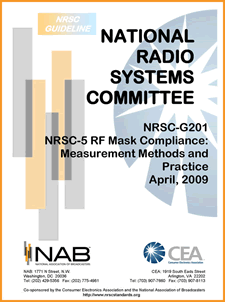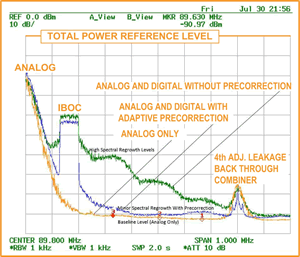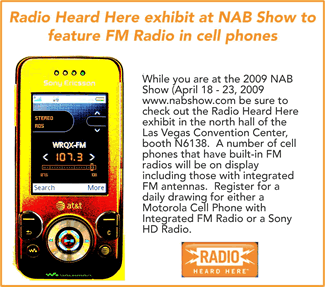 |
NRSC-G201
RF Mask Compliance Measurement Guideline Adopted
Nearly two
years of work came to fruition at the National Radio Systems Committee
(NRSC) DRB Subcommittee meeting, held last Saturday, April 18,
2009 in Las Vegas, NV (in conjunction with the 2009 NAB Show,
www.nabshow.com), when the
Subcommittee adopted an important NRSC Guideline document dealing
with  measurement
of RF mask compliance for AM and FM in-band/on-channel (IBOC)
digital radio signals. measurement
of RF mask compliance for AM and FM in-band/on-channel (IBOC)
digital radio signals.
NRSC-G201,
NRSC-5 RF Mask Compliance: Measurement Methods and Practice,
was adopted by the Digital Radio Broadcasting (DRB) Subcommittee
which is co-chaired by Andy Laird, Vice President and Chief Technology
Officer, Journal Broadcast Group, and Mike Bergman, Vice President,
New Digital Technologies, Kenwood USA. It was developed by the
Subcommittee’s IBOC Standards Development Working Group (ISDWG)
which is chaired by Dom Bordonaro, Chief Engineer, Cox Radio,
Connecticut. The ISDWG is also the group responsible for development
and subsequent modification of the NRSC-5 IBOC Digital Radio Broadcasting
Standard.
The
idea for developing this Guideline arose from the ISDWG’s
work on developing the “B” version of the NRSC-5 IBOC
Standard. The group recognized that, given the variety of IBOC
transmission facility configurations as well as the need to characterize
IBOC RF signals by both equipment manufacturers (during construction
and testing of IBOC transmission equipment) and broadcasters,
various methods must be utilized to determine compliance with
the RF masks specified by NRSC-5. The purpose of the Guideline
is to provide background information as well as detailed instructions
on the best methods and practices for determining compliance,
for both hybrid AM and hybrid FM IBOC, for the situations most
likely to be encountered.
Some of the
topics covered in this new NRSC Guideline, which is nearly 100
pages in length, include the following:
Modulating
signals and compliance measurement
(Section 4.2 – FM IBOC) – the signal(s) used for modulating
the analog portion of the HD Radio hybrid FM IBOC signal can introduce
variance in RF mask compliance measurement results. Since the
shape of the PSD envelope of the analog portion of the hybrid
signal is determined by the modulating signals applied to the
analog carrier, a test signal is recommended which results in
 repeatable
measurements, thereby eliminating variances due to the modulation.
The recommended test signal has been found to be more “demanding”
against the mask (by about 2 dB) than using “pink” noise
or program audio. repeatable
measurements, thereby eliminating variances due to the modulation.
The recommended test signal has been found to be more “demanding”
against the mask (by about 2 dB) than using “pink” noise
or program audio.
Troubleshooting
(Section 4.7 – FM IBOC) –intermodulation products, generally
caused by amplification problems, result in widened “shoulders”
of the digital OFDM subcarrier sidebands and in “spectral
regrowth” that appears as “beehive” bumps of energy
out of the station’s occupied bandwidth (see spectrum plot).
Suggestions on how to evaluate these types of problems are provided.
AM IBOC mask compliance procedures (Section 5.2.5) –
this section addresses use of both the 47 CFR §73.44 analog
peak mask (“legacy mask”) and the NRSC-5 hybrid AM IBOC
PSD masks when doing AM IBOC mask compliance measurements. A three-step
procedure is described involving a legacy analog mask measurement,
an analog-sideband-to-digital overlap measurement, and a full
hybrid IBOC measurement.
Measurement methodology – spectrum analyzers
(Section 6.1) – detailed information on the use and operation
of spectrum analyzers for purposes of performing IBOC RF mask
compliance measurements is provided, including information on
input levels, dynamic range, resolution bandwidth and noise bandwidth,
detectors, and limit lines. Specific recommended settings for
AM IBOC and FM IBOC measurements are also included.
Additional
material – six annexes are included as part of the NRSC
Guideline. Annex 1 is a white paper which provides more in-depth
information about the theory behind IBOC RF mask compliance measurements;
Annex 2 provides a list (currently unpopulated but entries are
expected in the near future) of “self-certified” test
and measurement equipment suitable for determining if an RF signal
is compliant with the NRSC-5 AM IBOC and FM IBOC emission masks;
Annex 3 is the test and measurement equipment self-certification
form; Annex 4 describes a method for measuring hybrid FM IBOC
signals on separate-line systems using a “CHIMP” (Combined
Hybrid IBOC Measurement Package); Annex 5 presents information
on recommended AM antenna bandwidth specifications for hybrid
AM IBOC; and Annex 6 is a short technical primer on AM transmitter
modulation theory.
This document
will be available free-of-charge on the NRSC’s web site at
www.nrscstandards.org,
following a final, procedural review which will take approximately
four weeks. Additional information about the NRSC, including information
on becoming a member, is also available on the web site.




The April 20, 2009 Radio TechCheck is also available
in an Adobe Acrobat file.
Please
click
here to read the Adobe Acrobat version of Radio TechCheck
|

